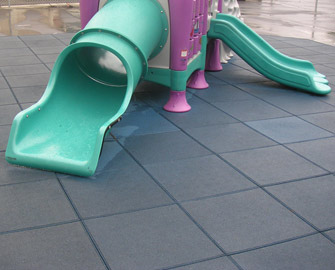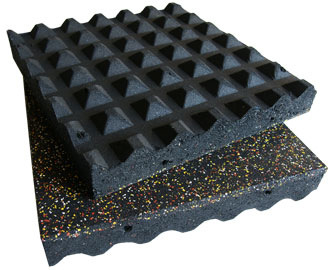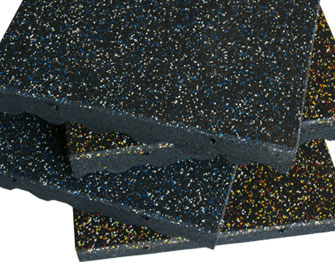|
|
Playground rubber flooring retains excellent shock absorption, non-slip, and environmental resistance properties that make it the best flooring option for playgrounds. Oftentimes, playground rubber flooring is made of durable recycled rubber material due to its excellent shock absorption and anti-slip properties as well as its lower playground surfacing cost. Recycled rubber mats for playgrounds are also ideal for both indoor and outdoor playset flooring as recycled rubber is highly resistant against damaging environmental factors. These safety tiles for playgrounds will also offer a customizable sizing option to ensure every part of the playground surface is safe for children. Furthermore, whether they are placed indoors or outdoors, playground rubber flooring will offer a long life in harsh settings and can withstand heavy levels of abuse.
What is the Best Flooring for a Playground?
The best flooring for a playground is rubber shock absorbent mats or loose-fill materials due to their excellent safety benefits that ensure a cushioned surface to prevent serious and life-threatening injuries. Shock absorbent interlocking rubber safety tiles for playgrounds are one of the most common types of playground rubber flooring options available. This type of playground rubber flooring is made of recycled rubber materials, allowing it to be a versatile indoor/outdoor playground flooring option. Safety tiles for playgrounds are also a customizable flooring option that can be made larger or smaller simply by adding or removing some tiles. This is a beneficial function to have in playground flooring as the size of the shock absorbing surface must extend out further than the general area around the playground equipment. For instance, “Proper placement and maintenance of protective surfacing is essential…Extend surfacing at least 6 feet from the equipment in all directions” (cpsc.gov). This 6-foot radius encompasses an area around the playground equipment called the playground “fall zone”, or “use zone”, and it is essentially the area children are expected to land on or exit from a piece of playground equipment. It is important to have this in place to avoid serious injuries from falls onto a hard playground surface. Case in point, because about 60% of playground injuries to children are the result of falls off playground equipment and onto a hard surface, it is important to provide sufficient coverage under and around equipment (earlychildhood.marylandpublicschools.org). Along with its customizable style, interlocking safety tiles for playgrounds also offer excellent shock absorption and are available in 3/4", 1”, 2.5”, and 3” thicknesses. Rubber is often used as a “shock and vibration absorber having elastic and viscous properties such as high inherent damping, deflection capacity, and energy storage” (journals.sagepub.com). Interlocking playground rubber flooring is an excellent shock absorbing surfacing that can absorb the force of impact and offer a cushioned surface between children and the hard surface below the tiles.

|

|
-
(a) What Do You Put on the Ground for a Play Area?
You put shock absorbent mats or loose-fill materials on the ground for a play area to provide a soft and cushioned surface for children to land on without worry of injury. Rubber shock absorbent mats and loose-fill materials are one of the most recommended playground rubber flooring options due to rubber’s excellent shock absorption properties. Oftentimes, playground rubber flooring is made of recycled rubber due to its excellent indoor/outdoor versatility, impact absorption, and a textured non-slip surface. For example, “Recycled rubber has been shown to provide safety benefits to children and others on playgrounds due to its ability to cushion the skull from head impacts and prevent other injuries due to a fall” (kdheks.gov). This is one of the most important properties of recycled rubber as most playground-related injuries are the result of a fall off playground equipment and onto a hard surface. Recycled rubber mats for playgrounds can also offer excellent anti-slip properties that are enhanced through its textured surface – a result of its manufacturing process. Because recycled rubber mats for playgrounds are made up of repurposed vehicle tires, it produces a textured surface that helps enhance rubber’s natural grippy surface by offering extra gripping points for sturdier footing. Additionally, rubber naturally enhances traction and its grippy surface will not be negatively affected by moisture present on its surface. These properties and capabilities of recycled rubber make it the ideal material to put on the ground for a play area.
(b) How Long Does Rubber Surfacing Last?
Rubber surfacing can last for years in both indoor and outdoor settings due to its excellent tear strength, abrasion resistance, and environmental resistance properties. Generally, recycled rubber is used to create playground surfacing and it retains a high tensile strength and resistance against damaging environmental factors, including UV rays, ozone, oxygen, and moisture. This is due to its repurposed vehicle tire composition, making it ideal for both indoor and outdoor playset flooring. Recycled rubber is made with post-consumer vehicle tires that have been grinded into a fine crumble and re-adhered back into a solid product or sheet. Vehicle tires frequently experience harsh and abrasive terrain; however, it is still able to maintain its integrity without falling apart. This same tear strength and abrasion resistance can be seen in recycled rubber tiles for playgrounds, allowing them to take the abuse of children jumping and running. Furthermore, recycled rubber tiles for playgrounds can also resist damaging environmental factors, including UV rays, ozone, oxygen, and moisture for excellent outdoor playset flooring. There are many performance-enhancing materials that are used in the composition of tires; however, the main two rubber materials used are natural rubber, butadiene rubber, styrene butadiene rubber, and halobutyl rubber. These four types of rubber give tires excellent resistance to wear and tear as well as excellent traction (ustires.org). There are other additives to the rubber materials, such as antioxidants and antiozonants. Antioxidants are used to help “keep rubber from breaking down due to the effect of temperature and oxygen exposure” while antiozonants are used “to impede the effects of exposure to ozone on the surface of the tires” (ustires.org). Due to these properties and additives of vehicle tires, playground rubber flooring can last for years in as both indoor and outdoor playset flooring.

|

|
(c) How Must Does Rubber Surface Cost?
A rubber surface can cost anywhere between $20.21 to $44.50 per tile depending on its thickness and the quantity. The playground surfacing cost of interlocking rubber tiles can rise as they get thicker because there is more material involved in making larger tiles. However, the recycled rubber crumb used to make playground rubber flooring is an eco-friendly repurposed material, allowing it to be more cost-effective than other variations of rubber, including natural and synthetic rubbers. The process of making recycled rubber does not require the production of new materials whereas natural and synthetic rubbers use a significant amount of labor and energy to create. In addition, the more playground rubber flooring tiles you purchase the less the individual tiles will be. Therefore, thanks to the recycled rubber composition of playground rubber flooring, it is a cost-effective option over other playground surfacing materials.
Playground rubber flooring is the best flooring for a playground because it can offer superior shock absorption and non-slip properties in both indoor and outdoor settings. Rubber safety tiles for playgrounds are made of recycled rubber that creates a cushioned surface to prevent life-threatening injuries from falls onto a hard surface. Recycled rubber mats for playgrounds are also highly resistant to damaging environmental factors, such as UV rays, ozone, oxygen, and moisture which, in turn, ultimately reduces the playground surfacing cost by allowing it to last for years in harsh outdoor settings. Overall, recycled playground rubber flooring will provide a long-lasting and cushioned surface that will help reduce chances of life-threatening injuries on playgrounds.
What is the Best Flooring for a Playground?
|
|
|